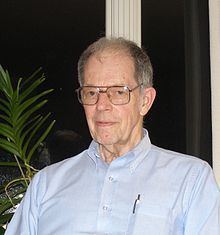Name Howard Pattee | ||
 | ||
Born October 5, 1926Pasadena, CA ( 1926-10-05 ) Fields Theoretical BiologyOrigin of lifeComplex SystemsArtificial lifeBiosemioticsBiocyberneticsPhysics of CodesSymbol Systems Thesis The Compound Reflection X-ray Microscope, Stanford, 1953. Doctoral students Michael Earl ConradPeter CarianiEric MinchLuis M. RochaDennis P. Waters Influences John von NeumannC. H. WaddingtonMichael PolanyiGeorge Polya Books LAWS, LANGUAGE and LIFE: Howard Pattee’s Classic Papers on the Physics of Symbols with Contemporary Commentary | ||
Residence United States of America | ||
Evolved Open-Endedness, Not Open-Ended Evolution (presented by Hiroki Sayama)
Howard H. Pattee (born October 5, 1926) is an American biologist, Professor Emeritus at Binghamton University and Fellow of the American Association for the Advancement of Science. He graduated at Stanford University in 1948 and completed a Ph.D. there in 1953.
Contents
- Evolved Open Endedness Not Open Ended Evolution presented by Hiroki Sayama
- Contributions
- Present title
- Previous positions
- Fellowships and awards
- Publications
- References
Contributions
Professor Pattee's main research interests are theoretical biology with a focus on origin of life, artificial life, biosemiotics, semiotic control of dynamic systems, and the physics of codes and symbols. His many contributions to the "symbol-matter" problem within the cell have had much influence on theoretical biology, biosemiotics, complex systems and artificial life.
Present title
Previous positions
Fellowships and awards
Publications
References
Howard H. Pattee Wikipedia(Text) CC BY-SA
